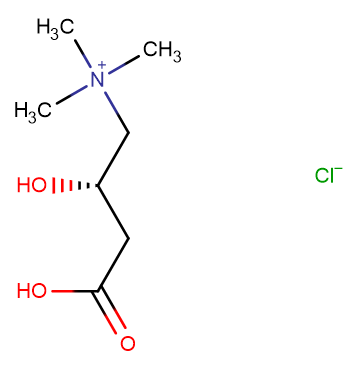
L-Carnitine hydrochloride
CAS No. 10017-44-4
L-Carnitine hydrochloride( —— )
Catalog No. M10022 CAS No. 10017-44-4
It is used therapeutically to stimulate gastric and pancreatic secretions and in the treatment of hyperlipoproteinemias.
Purity : >98% (HPLC)
 COA
COA
 Datasheet
Datasheet
 HNMR
HNMR
 HPLC
HPLC
 MSDS
MSDS
 Handing Instructions
Handing Instructions
| Size | Price / USD | Stock | Quantity |
| 5MG | 34 | In Stock |


|
| 10MG | 45 | In Stock |


|
| 25MG | 61 | In Stock |


|
| 50MG | 98 | In Stock |


|
| 100MG | 129 | In Stock |


|
| 200MG | 181 | In Stock |


|
| 500MG | Get Quote | In Stock |


|
| 1G | Get Quote | In Stock |


|
Biological Information
-
Product NameL-Carnitine hydrochloride
-
NoteResearch use only, not for human use.
-
Brief DescriptionIt is used therapeutically to stimulate gastric and pancreatic secretions and in the treatment of hyperlipoproteinemias.
-
DescriptionConstituent of striated muscle and liver. It is used therapeutically to stimulate gastric and pancreatic secretions and in the treatment of hyperlipoproteinemias. (In Vitro):When expressed in human embryonic kidney (HEK)293 cells, hOCTN2 (SLC22A5) shows low but significant stereospecific transport activity: D-carnitine is transported with lower affinity (Km=10.9 μM) than the L-isomer (Km=4.3 μM).
-
In VitroWhen expressed in human embryonic kidney (HEK)293 cells, hOCTN2 (SLC22A5) shows low but significant stereospecific transport activity: D-carnitine is transported with lower affinity (Km=10.9 μM) than the L-isomer (Km=4.3 μM).
-
In Vivo——
-
Synonyms——
-
PathwayOthers
-
TargetOther Targets
-
RecptorCRAT
-
Research AreaOther Indications
-
Indication——
Chemical Information
-
CAS Number10017-44-4
-
Formula Weight197.66
-
Molecular FormulaC7H15NO3·HCl
-
Purity>98% (HPLC)
-
SolubilityDMSO: > 10 mM
-
SMILESC[N+](C)(C)C[C@H](CC(=O)O)O.[Cl-]
-
Chemical Name——
Shipping & Storage Information
-
Storage(-20℃)
-
ShippingWith Ice Pack
-
Stability≥ 2 years
Reference
1. Merra G, et al. World J Gastroenterol. 2012 Sep 28;18(36):5065-7
molnova catalog



related products
-
BAY-678
BAY-678 is a human neutrophil elastase (HNE; IC50: 20 nM) inhibitor with oral bioactivity, potency and selectivity.BAY-678 is a chemical probe recommended by the Structural Genomics Consortium (SGC).
-
EN300-203561
EN300-203561
-
Thymohydroquinone
Thymohydroquinone (Thymoquinol) is a monoterpenoid phenolic compound found in thyme, oregano, and other plants in the labiaceae family.



 Cart
Cart
 sales@molnova.com
sales@molnova.com


